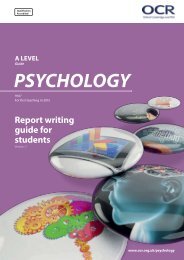PSYCHOLOGY
2bwO2e
2bwO2e
You also want an ePaper? Increase the reach of your titles
YUMPU automatically turns print PDFs into web optimized ePapers that Google loves.
Cognitive Psychology<br />
Memory – Grant, Clay, Ferrie, Groves, McDorman and Dark<br />
GRANT, H. M., BREDAHL, L. C., CLAY, J., FERRIE, J., GROVES, J. E., McDORMAN, T. A. and DARK, V. J. (1998)<br />
Context-Dependent Memory for Meaningful Material: Information for students.<br />
Applied Cognitive Psychology, 12, (6), 617-623.<br />
4. Sample<br />
• Eight members of a psychology laboratory class served as experimenters. Each experimenter recruited five acquaintances to serve as<br />
participants.<br />
• There were 39 participants, ranging in age from 17 to 56 years (M = 23.4, SD = 5.9), 17 were female, 23 were male. (1 participant’s results were<br />
omitted from the analyses.)<br />
5. Outline of the procedure/study<br />
• Each experimenter ran one participant for each of the four conditions and an additional participant for one of the conditions as assigned by the<br />
instructor. Experimenters randomly assigned their participants to their five conditions.<br />
• Stimuli<br />
(a) Each experimenter provided his/her own cassette player and headphones. The eight cassettes were exact copies made from a master tape<br />
of background noise recorded during lunchtime in a university cafeteria. The background noise consisted of occasional distinct words/phrases<br />
embedded within a general conversational hum that was intermixed with the sounds produced by movement of chairs and dishes. The tape<br />
was played at a moderately loud level.<br />
(b) A two-page, three-columned article on psychoimmunology (Hales,1984) was selected as the to-be-studied material.<br />
(c) 16 multiple-choice questions, each consisting of a stem and four alternatives were generated, all of which tested memory for points stated in<br />
the text. 10 short-answer questions were derived from those multiple-choice stems that could easily be restated to produce a question that<br />
could be answered unambiguously by a single word or phrase. The order of the questions on each test followed the order in which the tested<br />
points were made in the text. The short-answer test was always administered first to ensure that recall of information from the article was being<br />
tested and not recall of information from the multiple- choice test.<br />
. . . continues<br />
22





